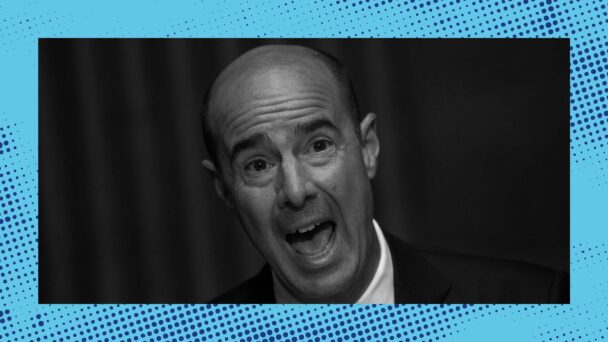The hot new trend in conservative judicial activism is judges simply ignoring facts when they don’t support a preferred result.
The latest data point for this phenomenon is Sisters for Life. v. Louisville-Jefferson County, which the Sixth Circuit Court of Appeals decided late last month. In that case, Kentucky anti-choice activists who call themselves “sidewalk counselors” sued the government of Louisville-Jefferson County after it passed a buffer zone law affecting the EMW Women’s Surgical Center in Louisville. This type of law is designed to prevent people from blocking entrances to medical facilities, particularly abortion clinics. Although anti-choice activists contend that buffer zones violate their First Amendment free speech rights, courts have long held buffer zones to be constitutional, provided that they comply with certain size limits.
Louisville’s law is a narrow one: It prevents everyone except EMW patients, staff, and volunteers from blocking the sidewalk from the entrance of a healthcare facility to the closest sidewalk curb, and a ten-foot zone on either side. That’s all, though. It doesn’t prohibit, for example, screaming at the patients walking to the clinic. It doesn’t prohibit those screaming protesters from lining up along the sidewalk, forming an anti-choice gauntlet through which anyone seeking care must pass. It doesn’t prohibit anti-choice activists from holding signs with graphic images of aborted fetuses. It only prohibits, as the lower court explained, “physically obstructing a patient from entering the healthcare facility.” Anyone walking down the middle of the sidewalk is within five feet of the protesters, and can easily hear anything and everything the protesters have to say.
Given these facts, the lower court declined to block the buffer zone law from taking effect. But on appeal, a three-judge panel of George W. Bush appointees Jeffrey Sutton and Richard Allen Griffin and Trump appointee John B. Nalbandian reversed, holding the buffer zone unconstitutional because requiring the plaintiffs to stay ten feet away from patients inhibited their ability to share their message. The opinion placed great weight on the protesters’ contention that they engage with patients in a “quiet, caring, personal manner”: “The goal of the plaintiffs is not to harass or protest, whether loudly or violently,” Sutton wrote. “The point of their speech is to offer a compassionate ear.”
This “quiet, caring, personal” business is fiction. As the government explained, the so-called counselors “regularly harass, stalk, intimidate, and assault patients entering and exiting the clinic,” requiring a “constant police presence” at the clinic. The county routinely had to arrest and cite people for actions ranging from property destruction to intimidation and harassment to criminal trespass. Asking staff and patients to file complaints proved counterproductive, because those who complained face further retaliation from the protestors, including calls to their family and to clergy. EMW’s records tallied 1,447 protesters in two months between January and March 2021, with an average of 23 per day. A video submitted by the government shows a protester grabbing a patient and dragging them away from the entrance.

Anti-choice activists lending a “compassionate ear” (Screencap via EMW)
In the hands of the Sixth Circuit, however, this record of abuse, harassment, and violence just disappears. The buffer zone, Sutton concluded, makes “quiet” conversations “difficult if not impossible,” and requiring protesters to stop at the borders unfairly makes them appear “untrustworthy” or “suspicious.” His opinion also treats the failure of protesters to persuade women not to enter the clinic—one man reported that the law has “practically eliminated” his ability to perform “sidewalk counseling”—as evidence of the law’s unconstitutionality. The possibility that more women are obtaining care because the law offers marginal protections from violent harassment by anti-choice activists seems not to have occurred to Sutton.
This panel’s willingness to ignore the record is not an isolated occurrence in the federal courts these days. In October 2022, the Fifth Circuit pulled a similar stunt when it reviewed the case of Wayne Mack, a Texas justice of the peace who opens court every morning with a lengthy prayer. Numerous people said Mack scans the audience during the prayer, watching to see who is appropriately penitent and who is not. But the Fifth Circuit panel took Mack at his word: Although a lawyer who appeared before Mack explained he felt compelled to stay for the prayer so his clients wouldn’t be disadvantaged, the panel simply declared that this belief was unreasonable. The panel concluded that Mack’s performance is not state-sponsored prayer only after throwing out every piece of the record showing that Mack’s performance is exactly that.
Both circuits likely learned this trick from the Supreme Court. In Kennedy v. Bremerton, the school prayer case decided last term, Justice Neil Gorsuch delivered a master class in making shit up. His majority opinion transformed a high school football coach’s prayer at 50-yard line, delivered while surrounded by players from both teams with helmets held aloft, into the tale of a humble man who “offered his prayers quietly while his students were otherwise occupied.” In this era of a 6-3 Supreme Court supermajority, conservative fantasies have become jurisprudential realities.
All of these refusals to engage with real-world facts are rewriting the First Amendment in real time. According to these judges, the Bill of Rights protects not only conservatives’ right to speech, but their right to force others to listen to it, too. When they feel that facts are on their side, emboldened conservative judges can rule however they want. And when the facts are not on their side, emboldened conservative judges are free to make some up.




